Tourism in Bulgaria is a significant contributor to the country's economy. Situated at the crossroads of the East and West, Bulgaria has been home to many civilizations: Thracians, Greeks, Romans, Eastern Romans or Byzantines, Slavs, Bulgars, and Ottomans. The country is rich in tourist sights and historical artifacts, scattered through a relatively small and easily accessible territory. Bulgaria is internationally known for its seaside and winter resorts.
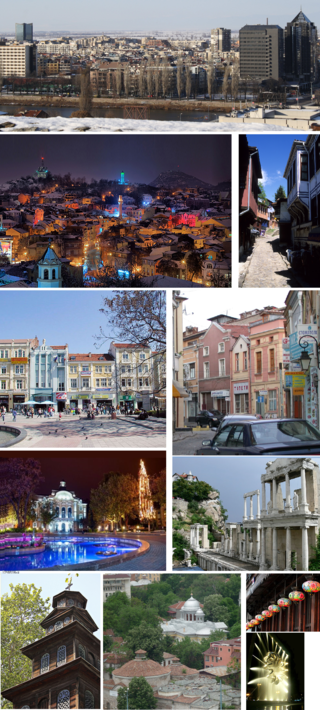
Plovdiv (Bulgarian: Пловдив, pronounced[ˈpɫɔvdif] is the second-largest city in Bulgaria, 93 miles southeast of the capital Sofia. It had a population of 371,536 as of 2024 and 675,000 in the greater metropolitan area. Plovdiv is a cultural hub in Bulgaria and was the European Capital of Culture in 1999 and 2019. The city is an important economic, transport, cultural, and educational centre. Plovdiv joined the UNESCO Global Network of Learning Cities in 2016.

Dobrich is the 9th most populated city in Bulgaria, the administrative centre of Dobrich Province and the capital of the region of Southern Dobrudzha. It is located in the northeastern part of the country, 30 km west of the Bulgarian Black Sea Coast, not far from resorts such as Albena, Balchik, and Golden Sands. In January 2012, Dobrich was inhabited by 79,269 people within the city limits. The city is named after the Bulgarian medieval lord of the surrounding region - Dobrotitsa. Agriculture is the most developed branch of the economy. The most popular types of agricultural products in the region are wheat and lavender oil.
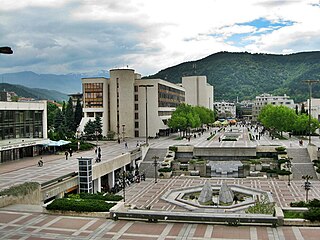
Blagoevgrad is а town in Southwestern Bulgaria, the administrative centre of Blagoevgrad Municipality and of Blagoevgrad Province. With a population of almost 70,000 inhabitants, it is the economic and cultural centre of Southwestern Bulgaria. It is located in the valley of the Struma River at the foot of the Rila Mountains, 101 kilometres south of Sofia, close to the border with North Macedonia.

Koprivshtitsa is a historic town in the Koprivshtitsa Municipality in Sofia Province, central Bulgaria, lying on the Topolnitsa River among the Sredna Gora mountains. It was one of the centres of the April uprising in 1876 and is known for its authentic Bulgarian architecture and for its folk music festivals, making it a tourist destination.
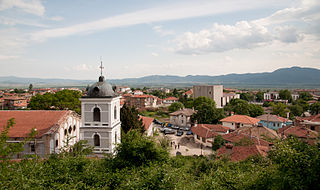
Sopot is a Bulgarian town situated in the fertile sub-Balkan mountain valley of Karlovo, immediately below the steep southern slopes of the Troyan Balkan Mountain. Sopot is part of Plovdiv Province and is the administrative centre of a municipality with the same name.

Tryavna is a town in central Bulgaria, situated in the northern slopes of the Balkan range, on the Tryavna river valley, near Gabrovo. It is famous for its textile industry and typical National Revival architecture, featuring 140 cultural monuments, must, and expositions. Tryavna is the birthplace of Bulgarian writer Pencho Slaveykov and revolutionary Angel Kanchev.

The Bulgarian Revival, sometimes called the Bulgarian National Revival, was a period of socio-economic development and national integration among Bulgarian people under Ottoman rule. It is commonly accepted to have started with the historical book, Istoriya Slavyanobolgarskaya, written in 1762 by Paisius, a Bulgarian monk of the Hilandar monastery at Mount Athos, leading to the National awakening of Bulgaria and the modern Bulgarian nationalism, and lasting until the Liberation of Bulgaria in 1878 as a result of the Russo-Turkish War of 1877–1878.

Panagyurishte is a town in Pazardzhik Province, Southern Bulgaria, situated in a small valley in the Sredna Gora mountains. It is 91 km east of Sofia, 43 km north of Pazardzhik. The town is the administrative center of the homonymous Panagyurishte Municipality. Panagyurishte is an important industrial and economic center, the hub of the Bulgarian optical industry and a major copper extraction and processing site. According to the 2021 census, it had a population of 15,275. Panagyurishte is a town of significant historical importance, being the center of the 1876 April Uprising against the Ottoman Empire. The renowned Thracian Panagyurishte Treasure was found near the town.

Karlovo is a historically important town in central Bulgaria located in a fertile valley along the river Stryama at the southern foot of the Balkan Mountains. It is administratively part of Plovdiv Province and has a population of about 19,373, the mayor being Dr. Emil Kabaivanov.

Pazardzhik is a city situated along the banks of the Maritsa river, southern Bulgaria. It is the centre of Pazardzhik Province and Pazardzhik Municipality. It is located in the Upper Thracian Plain and in the Pazardzhik-Plovdiv Field, a subregion of the plains. It is west of Plovdiv, about 37 kilometres (23 mi), 112 kilometres (70 mi) southeastern of Sofia and 288 kilometres (179 mi) from Burgas. The population is 55,220, as it has been growing around from the end of the 19th century to the end of the 20th century. The city reached its highest milestone, exceeding 80,000. Due to poor economic performance in Bulgaria during the 1990s and early 2000s, emigration of Bulgarians began, which affected Pazardzhik as well.
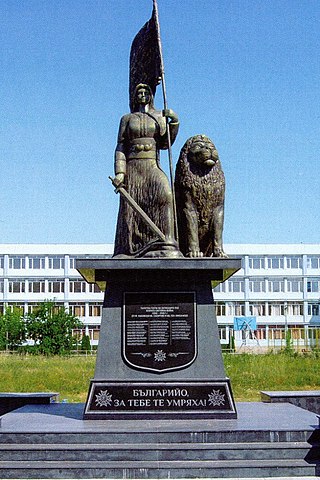
Rakovski is a town in southern Bulgaria, in the historical region of Thrace. It is located in the Plovdiv Province. The town is also the centre of the Rakovski Municipality. Rakovski was founded in 1966 with the merging of three villages — General Nikolaevo, Sekirovo, and Parchevich. The new town was named after the prominent Bulgarian revolutionary Georgi Sava Rakovski.

The Plovdiv Regional Historical Museum is a historical museum in the city of Plovdiv, Bulgaria. Established in 1951, it covers the history of Plovdiv from the 15th century until today. It has three departments, each occupying a separate historic building.
100 Tourist Sites of Bulgaria is a Bulgarian national movement established in 1966 to promote tourism among Bulgaria's most significant cultural, historic, and natural landmarks.
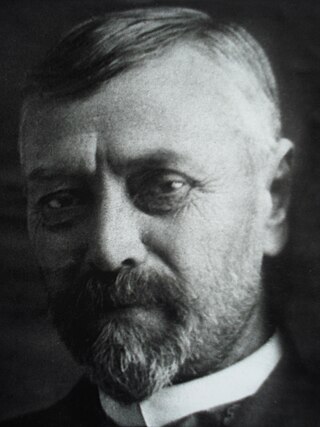
Kamen Petkov was a Bulgarian architect based in Plovdiv, Bulgaria.

The Plovdiv Regional Ethnographic Museum is a museum of ethnography in Plovdiv, Bulgaria. Since 1938, it has occupied the 1847 house of the merchant, Argir Kuyumdzhioglu, in the city's Old Town. The museum features six exhibitions, each occupying a separate room.

Hristo Gruev Danov was a Bulgarian enlightener, teacher and book publisher of the Bulgarian National Revival who is regarded as the father of organized book publishing in the Bulgarian lands and hailed as the "Bulgarian Gutenberg". After the Liberation of Bulgaria in 1878, he was also a politician and mayor of Plovdiv.

Hisar Kapia is a medieval gate in Plovdiv's old town and one of the most famous tourist sights in the city. The gate was built in the 11th century AD over the foundations of a gate from Roman times. Hisar Kapia is one of the three entrances to the acropolis of ancient Plovdiv. During the rule of the Ottoman empire revival houses were embedded in the remains of the old stone walls around the gate.

The old town in Plovdiv is an architectural and historical reserve located on three of Plovdiv's hills: Nebet Tepe, Dzhambaz Tepe and Taksim Tepe.

The Clock tower of Botevgrad is the symbol of the town and a part of 100 Tourist Sites of Bulgaria. Its clock mechanism still rings every hour with a respective number of bell rings based on the current hour. It was constructed in 1866.


























